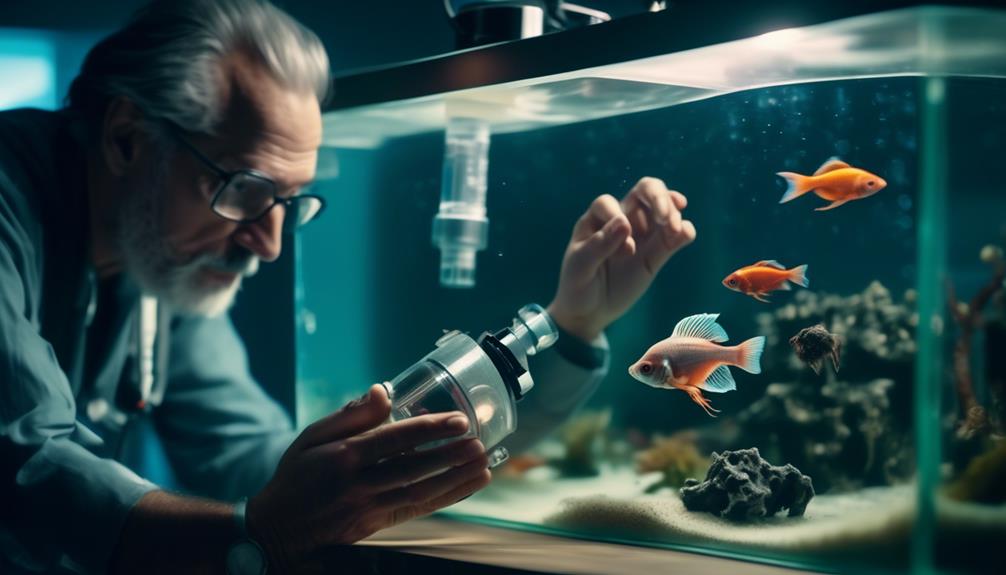Is aquarium salt really the panacea for ailing betta fish that many enthusiasts claim it to be? I’ve spent considerable time researching and experimenting with various treatments for common betta ailments, and the use of aquarium salt is often a go-to recommendation.
The idea is that a controlled addition of salt to your betta’s environment can work wonders, alleviating symptoms of diseases such as fin rot and ich. It’s said to be a simple, natural method that mimics the betta’s native habitat and boosts their overall health.
In practice, however, the effectiveness of this treatment can vary, and it’s crucial to understand the nuances of salt therapy before taking the plunge. Join me as I explore the proper ways to harness the benefits of aquarium salt, while also considering the potential risks it poses to our finned friends.
What’s certain is that the well-being of our beloved bettas is at stake, and finding the right balance could make all the difference.
Mike’s Thoughts

While it’s an effective treatment for certain conditions, it’s not a panacea for all ailments.
If a betta does not respond to salt treatment, consulting a veterinarian is crucial for the health and well-being of your fish.
I’ve added more detail below that expands on the topic, so feel free to read on and leave a comment if you have any questions or reach me on Facebook.
What Is Aquarium Salt?
Aquarium salt and regular salt are chemically the same.
They both have the chemical formula NaCl, showing they are made of equal parts sodium and chloride.
The difference is that table salt has extra ingredients added to it.
In contrast, aquarium salt is pure because it is made by evaporating seawater.
Understanding Aquarium Salt
Aquarium salt is a go-to remedy for treating several common betta fish illnesses, including fungal infections and fin rot, by effectively dehydrating harmful microbes in the tank. When I noticed my betta showing signs of disease, I knew I’d to learn about the proper use of aquarium salt to help my little buddy.
Using aquarium salt for betta health is a bit like being a scientist; you’ve got to get the dosage just right. For different betta diseases, the salt concentration needed can vary. It’s not just about tossing a pinch in and hoping for the best, it’s about understanding what your betta is up against. Whether it’s the dreaded white spot disease or the pesky velvet, knowing the right amount to use is critical.
Salt treatment isn’t just about fighting off the bad guys in the water. It’s about making sure you don’t hurt your plant pals or other fish friends that mightn’t be as salt-tolerant as your betta. That’s why I always check the tolerance of my tank’s residents before starting any salt therapy.
What’s more, it’s essential not to overdo it with the salt. Overdosing can lead to bigger problems, like diseases getting tough and resistant. And that’s a headache no one wants. I make sure to measure accurately and follow a treatment schedule that includes water changes to keep things balanced.
The Healing Properties

Harnessing the healing powers of aquarium salt, I’ve seen firsthand how it combats various pathogens afflicting my betta by boosting the water’s salinity to therapeutic levels. This simple substance has been a game-changer for my sick betta, especially when bacterial infections loom. You wouldn’t believe how something as common as salt can play such a crucial role in aquatic care!
Aquarium salt doesn’t just work on a whim; it’s got science backing it up. It helps by giving those nasty bacteria and fungus the boot—through dehydration, no less.
The salt increases the water’s salinity, which in turn uses osmosis to suck the life out of those pathogens clinging to my fish. It’s like watching an invisible battle where the good guys—those healing properties of the salt—are winning.
I’ve also noticed that regular water changes are essential when using aquarium salt to treat my betta. Sure, it’s a bit of extra work, but it’s worth it to ensure the water stays clean and the salt concentration remains effective. And let’s talk about the fish’s slime coat—that protective layer is crucial. Aquarium salt helps bolster this natural defense, which is pretty much a superhero cape for fish.
But here’s the thing: you’ve got to use the right dose. Whether it’s 1 tablespoon per 3 gallons for a milder issue or upping the ante to 1 tablespoon per gallon for something more severe, accuracy is key.
Low Dose
Just a soup spoon of salt for every three gallons of water works. Mix it in the water or dissolve it first.
It’s a gentle way to fight fin rot and other germs, and it makes your Betta slimy in a good way to keep bugs off.
Let your Betta swim in this salt water for four to five days, then add more if they’re still sick.
Mid Dose
Use a soup spoon of salt for every two gallons for tougher problems.
It fights other diseases and is good for ten days, then you can add even more salt if you need to.
High Dose
The most salt you can use is a soup spoon per gallon, but don’t use it if you have other fish without scales or plants, or you’ll hurt them.
Overdosing can do more harm than good, and that’s the last thing I want for my finned friend. So, measuring carefully and treating wisely—that’s my mantra for bringing my betta back to health with aquarium salt.
Aquarium Salt’s Extra Good Things
Aquarium salt adds important stuff called electrolytes to the water, so my Betta can breathe better and get rid of bad air.
It also cuts down bad things like nitrites and nitrates and stops a blood problem.
This salt helps my Betta’s gills and kidneys work right, which is super important.
Salt Treatment Preparation
Before we get our sick betta on the road to recovery with salt therapy, I’ll guide you through getting everything set up right.
I’ll show you how to measure the salt precisely because getting the dose just right is crucial for your fish’s health.
Then, we’ll go over preparing the aquarium water and keeping a close eye on how your betta responds to the treatment.
Measuring Correct Salt Dosage
To ensure your betta’s safety during salt treatment, it’s crucial to measure the correct dosage of aquarium salt with precision. When I’m treating my sick betta, I follow these simple steps:
- I always check the label on the salt for Betta fish to see the recommended amount, usually around 1 tablespoon per gallon.
- I use a measuring spoon to scoop the exact level of salt needed.
- Before I add salt directly to the tank, I dissolve it in a separate container of water to prevent harm to my betta, especially since they’re not scaleless fish.
- I gradually introduce the salt bath to the aquarium, monitoring my betta for any signs of distress.
Aquarium Water Conditioning Steps
When preparing for a salt treatment, it’s essential to choose aquarium salt that’s specifically made for fish tanks to guarantee it will be safe and effective for your betta.
Before treating my sick betta with salt, I always check if my freshwater aquarium plants can handle it. It’s important to know which plants and tankmates are salt-tolerant.
I’m careful to consider illnesses like fin rot, white spot, and wounds when deciding on salt treatment. It’s crucial to protect my betta’s slime coat while ensuring the aquarium water gets the right level of salt.
I adhere strictly to the recommended dosage and treatment process, as the wellbeing of my aquatic buddy depends on my diligence in conditioning the water properly.
Monitoring Betta’s Salt Therapy
As I begin the salt treatment for my betta, I’m vigilant in monitoring its effects and adjusting the aquarium conditions accordingly. It’s crucial to keep a close eye on several key factors:
- Aquarium Salt Dosage: I carefully measure the salt to ensure I’m not overdoing it, which could harm my sick betta or disrupt the water quality.
- Water Quality Checks: Regular testing of the water lets me track any changes that might occur due to the added salt.
- Observing My Betta: I watch for signs of improvement or distress, adjusting the treatment as needed.
- Tankmates and Plants: If the salt might affect other inhabitants, I’ll treat the whole tank or use a separate container to apply the salt directly to my betta.
Education and caution are my guides through this process.
Dosage Guidelines

Understanding the correct dosage of aquarium salt can make a significant difference in treating your sick betta fish. I know it might feel a bit overwhelming at first, but I’m here to break down the dosage guidelines so you can help your betta fight off those nasty illnesses.
First things first, always use aquarium salt that’s made for freshwater aquariums. This isn’t the same as the table salt we sprinkle on our fries! The right kind of salt is formulated to treat betta illnesses without causing harm.
Now, how much salt should you use? It’s not a one-size-fits-all answer because different sicknesses need different amounts of salt. For a general Level 1 Treatment, which is usually for mild conditions, you’ll want to mix 1 tablespoon of aquarium salt per 3 gallons of water. This helps with mild cases of bacterial and fungal infections, and it can ward off some parasites and microorganisms that aren’t too tough.
If your betta’s condition is more serious, you might need to up the ante. That’s where Level 2 Treatment comes in. This means using 1 tablespoon of salt for every 2 gallons of water. It’s a stronger dose, so it’s better suited for kicking those stronger bacterial and fungal infections to the curb.
Remember, accuracy is key. Too little salt mightn’t do the trick, and too much could harm your betta. Measure carefully, and always dissolve the salt in a separate container before adding it to your betta’s tank. This ensures even distribution and prevents any sudden spikes in salinity that could stress your fish even more.
Following these guidelines will give your betta a fighting chance to recover and thrive once again.
Administering the Treatment
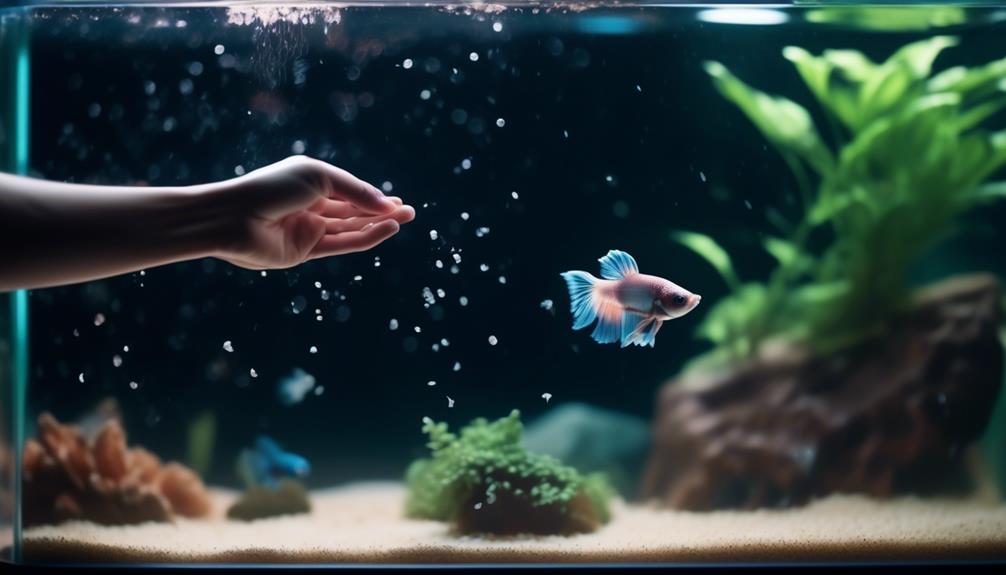
Now that we’ve covered the right dosage, let’s focus on how to properly administer the aquarium salt treatment to your sick betta. Treating betta fish diseases with salt can be effective, but it’s crucial to do it correctly to avoid further stress to your fish. Here’s a straightforward guide to get you started:
- Dissolve the Aquarium Salt: Before adding it to your betta’s tank, make sure the aquarium salt is fully dissolved in a separate container of water. This prevents undissolved granules from burning your fish’s delicate skin or gills.
- Use a Quarantine Tank: If possible, transfer your sick betta to a quarantine tank for treatment. This not only makes it easier to monitor their progress but also prevents the spread of fish disease to any tank mates.
- Administer Salt Baths: For a more intense treatment, you might opt for a short-term salt bath. Carefully place your betta in a separate container with the salt solution, ensuring you’ve acclimated them to prevent shock. Monitor closely during this time.
- Remove the Salt After Treatment: Once the treatment period is over, gradually transition your betta back to regular, salt-free water. This helps their body adjust and prevents any potential negative reactions.
Monitoring Your Betta
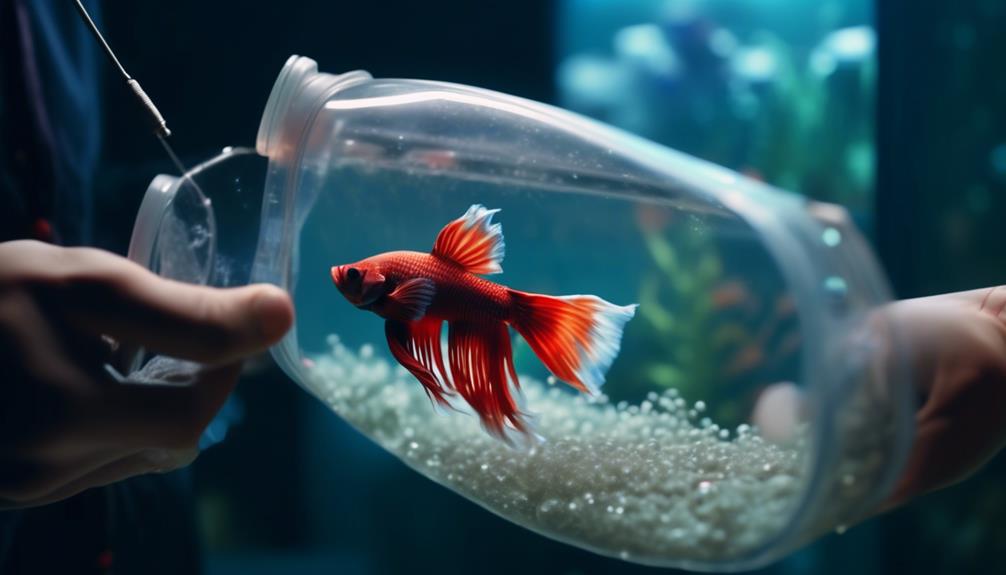
Keeping a watchful eye on your betta during salt treatment is key to ensuring their swift recovery. When I’ve used aquarium salt to help a sick betta, I’ve learned how important it’s to monitor their progress closely. You can’t just add salt and hope for the best. Instead, you need to be almost like a detective, looking for clues that show how your betta is healing.
First off, I check the water quality daily. Salt treatment can change the water parameters, so it’s crucial to keep everything balanced. I use a water test kit to measure things like ammonia, nitrite, and pH levels. If something’s off, I make small adjustments right away. This helps prevent further stress on my betta, which could slow down their healing.
I also keep an eye on my betta’s behavior. Are they swimming more actively? Do they’ve a good appetite? These are positive signs that the salt treatment is working. But if my betta is still sluggish or not eating, it might mean the illness is more serious, or the treatment isn’t quite right.
Duration of Salt Therapy
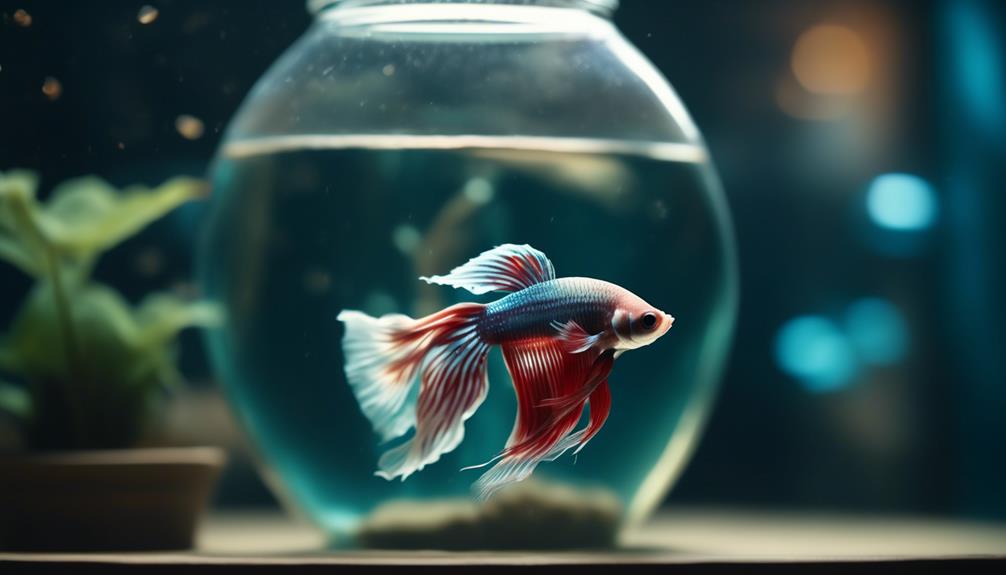
Now, let’s talk about how long you should keep up with salt therapy for your betta.
I’ll guide you through the treatment time frame and highlight the importance of closely watching your fish for any signs of improvement or distress.
Treatment Time Frame
Determining the proper duration for your Betta’s salt therapy is crucial, as it varies depending on their health and the severity of their illness.
Here’s a straightforward guide I’ve put together for the treatment time frame:
- Continuous Use: Keep the Aquarium Salt in the water until your sick betta shows signs of healing, but be mindful of not overdoing it to avoid causing more harm than good.
- Water Changes: Perform ongoing partial water changes to gradually remove salt from the aquarium.
- Salt Baths: Limit Epsom salt baths to a maximum of 15 minutes per session.
- Severe Cases: For serious conditions, administer salt therapy multiple times a day over several days.
Always remember, if you’re unsure, it’s best to consult an expert for advice tailored to your Betta’s needs.
Monitoring Salt Effects
To ensure your Betta’s speedy recovery, it’s essential to closely watch how they respond to the salt therapy and adjust the treatment accordingly. Sodium chloride, or Aquarium Salt, can be a great help, but I’ve got to be careful. I need to monitor salt effects because too much might hinder the healing or even kill my betta!
As I observe my fish getting better, I’ll gradually lower salt levels in the aquarium through partial water changes. If I’m nervous about adding salt directly to the tank, I might go for a salt bath or dip.
I’ll move my Betta to a separate container with salted water for up to 15 minutes, then put them back in the tank. But I’ll always watch closely for any signs of distress.
Potential Side Effects
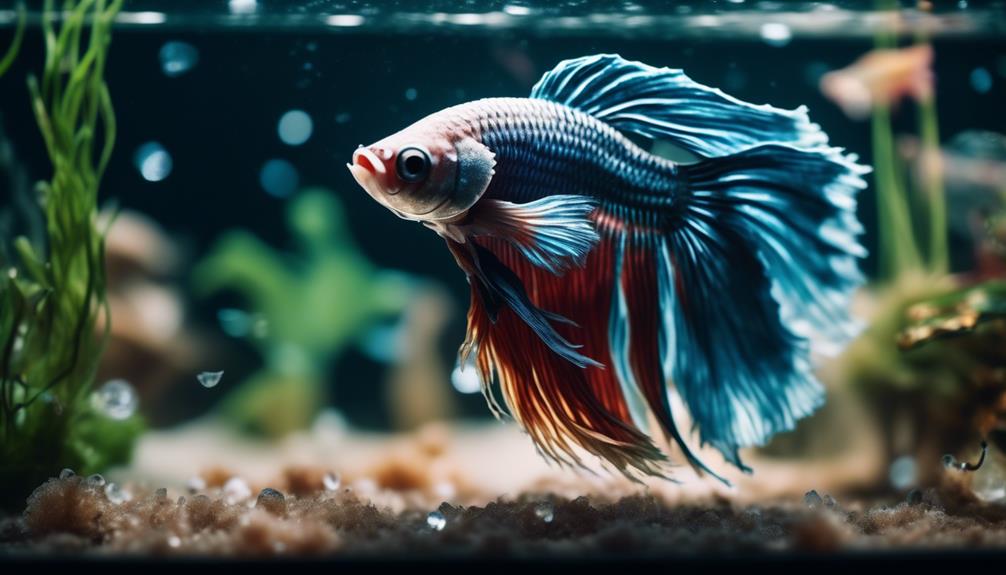
While aquarium salt can be a lifesaver for a sick betta, it’s crucial to understand that overdoing it can have serious side effects for your fish and their home. Here’s a quick rundown of what might go wrong if I’m not careful with the amount of salt I add:
- Sodium and Chloride Build-up: Higher salt concentrations can lead to an excess of sodium and chloride. Over time, this build-up can harm my betta and the beneficial bacteria that keep the tank ecosystem balanced. It’s like adding too much seasoning to a dish – a little might enhance the flavor, but too much can ruin it.
- Harm to Live Plants: Many live plants in my aquarium mightn’t tolerate the increased salinity. They could wilt or even die, which not only affects the aesthetics of the tank but also the natural balance. Plants are the lungs and décor of the aquarium world, so it’s essential to keep them healthy.
- Tank Mate Sensitivity: If I’ve other critters sharing space with my betta, such as snails, shrimp, or scaleless fish, they mightn’t be as salt-tolerant. These tank mates could suffer or perish due to the salt, which isn’t fair to them and could unbalance my tank’s harmony.
- Disease Resistance and Osmotic Stress: Misusing aquarium salt might lead to my betta’s diseases becoming resistant to its healing effects. Additionally, incorrect dosing can cause osmotic stress, messing with the fish’s swim bladder and overall health. It’s a bit like antibiotics – using them wrong could make the bugs stronger and the medicine less effective.
In short, while aquarium salt is a fantastic tool for helping my betta get back to good health, I’ve to remember that moderation is key to prevent these side effects.
When to Seek Professional Help
Understanding that moderation is key with aquarium salt, it’s equally important to recognize when it’s time to get expert advice for my betta’s health. When I’m caring for my sick betta with salt water treatments, I keep a close eye on its condition every day. If, despite my best efforts, my fish looks healthy but isn’t acting right, or if its symptoms are getting worse, that’s my cue to seek professional help.
It’s not always easy to tell when a betta fish needs more than home care. Sometimes, the signs are subtle—a little less enthusiasm for food, a bit more time spent at the bottom of the tank. But when these small changes start adding up, or if I notice any sudden and severe symptoms, I don’t hesitate to call in the experts. Aquarium fish, especially bettas, can be delicate, and what seems like a minor issue can quickly turn serious.
If my betta’s health keeps deteriorating despite the salt treatment, or if it shows signs of extreme distress such as difficulty swimming or labored breathing, I know it’s time to contact an aquatic veterinarian. They can provide a thorough examination and potentially diagnose issues that I might’ve missed.
Remembering that my ultimate goal is the well-being of my fish, I’d rather be safe and get professional advice than risk the health of my pet. After all, when it comes to taking care of my betta, I always want to ensure I’m doing the best I can for its health and happiness.
Frequently Asked Questions
How Do You Use Aquarium Salt for Sick Bettas?
I’ll carefully measure the salt dosage, ensuring it aligns with my betta’s water parameters. During treatment, I’ll monitor the acclimation process in a quarantine tank to support its immune system and reduce stress.
Does Aquarium Salt Help Sick Fish?
Yes, salt can help sick fish by improving their osmotic balance, boosting immunity, and reducing stress. It’s key in water chemistry and can sometimes be a gentler medication alternative, despite some misconceptions.
What Is the Best Method to Heal Sick Betta?
To heal a sick betta, I’d focus on disease identification and water parameters first. Quarantining, reducing stress, and providing nutritional support are key. I’d consider medication options and environmental enrichment too.
Can Table Salt Heal Fish?
I wouldn’t use table salt to heal fish because it lacks the minerals they need and can disrupt osmoregulation, leading to salt toxicity. It’s crucial to stick to aquarium salt as a medication alternative.
Conclusion
So, I’ve seen firsthand how aquarium salt can be a game-changer for my sick betta. It’s all about hitting the right dose and keeping a close eye on the little guy.
If there’s no improvement or things look worse, I don’t hesitate to call a vet. Remember, it’s a great fix for some issues, but not a cure-all.
Here’s to healthy, happy bettas with just a pinch of salt and a whole lot of care!
